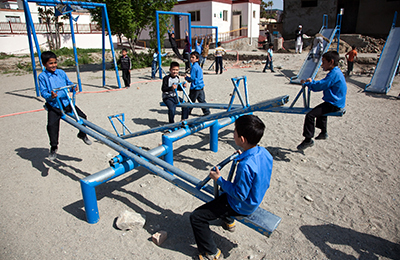Research Brief
Lessons from US Interventions to Japan, Afghanistan and Iraq
- Japan’s post-war liberalizing reforms were a success. This was partly due to the fact that US occupation preserved the strength of national institutions and made effective use of their capacity.
- Improvement in the scope of the state and the strength of Afghan institutions has been weak, despite the aims of the US occupation.
- The US occupation failed to preserve the pre-existing capacity of Iraqi state institutions, and free-market reforms have had a negative effect on the country’s non-oil economy.
Military intervention as state building
Persistent state weakness and failure can be a source of chronic violence, insecurity, and economic stagnation for a country. With many in the international community calling for intervention in various locations around the world, a better understanding of the consequences of past interventions is critical.
Experts remain divided over whether foreign military intervention can be an effective mechanism for building durable institutions in fragile states, and under what conditions this strategy is most likely to succeed. In Japan, Iraq, and Afghanistan, the US sought to build democratic institutions and practices through military occupation and reconstruction that could survive the withdrawal of US support. Each of these cases produced very different outcomes.
Japan
The US occupation of Japan during 1945-52 was highly attuned to the scope and strength of Japanese state institutions. In comparison to US interventions in Iraq and Afghanistan, planning for the occupation and political reconstruction of Japan began earlier and was more comprehensive.
 The US maintained many of the pre-war state structures that underpinned Japan’s strong institutional capacity, including a highly effective national bureaucracy led by an efficient, non-partisan, professional class of civil servants.
The US maintained many of the pre-war state structures that underpinned Japan’s strong institutional capacity, including a highly effective national bureaucracy led by an efficient, non-partisan, professional class of civil servants.
In addition, while the US occupation purged the government of many of the individuals associated with the previous ruling regime, it did not do so in a way that risked weakening the underlying administrative capacity of the Japanese state. The result was that the capacity of Japanese national political institutions was not fundamentally affected by the purge process.
Finally, the US initiated an array of social and economic reforms designed to create the conditions for sustainable liberal democracy—such as breaking up large industrial conglomerates, and instituting land reform. In the process, it successfully built institutional capacity where it had not previously existed.
Iraq
The US approach to state-building in Iraq from 2003 to 2011 failed to preserve the existing capacity of Iraqi state institutions. The US war plan envisioned a relatively small force that would enter and exit Iraq quickly. In contrast with the Japanese occupation, decision makers under the Bush administration initially rejected the idea of creating a formal occupation authority. Even after the administration was compelled to form a more structured occupation authority, the US reform agenda continued to dismantle and undermine the capacity of Iraqi state institutions.
This reform agenda focused on reducing the scope of the Iraqi state, which US officials viewed as bloated and inefficient. The result was the introduction of free market-oriented reforms, including privatizing state-owned companies, rolling back the state sector, and eliminating a vast network of state subsidies. These initiatives had a negative impact on Iraq’s non-oil economy, while creating hundreds of thousands of unemployed workers and alienating the managerial classes. The US decision to dissolve the Iraqi military and other security institutions further undermined the state and contributed to the outbreak of anti-government violence.
 Afghanistan
Afghanistan
The military stabilization operation in Afghanistan from 2001 to 2013 involved a more limited direct military commitment than Japan and Iraq. The US intervention focused on building the strength of Afghan institutions, but failed to make significant progress in accomplishing this goal. The US also attempted to expand the state into new areas—such as education, which had previously been under local/regional control—and to expand the reach of government institutions and services into regions where they had previously been absent. Yet the Afghan state still seems unable to deliver many basic services outside the capital region of Kabul. The US attempted to attach certain governance conditions to assistance but did not withhold aid when these were not met, which may have led state leaders to behave even more recklessly.
Lessons for future intervention
- It is easier for international actors to preserve existing state strength than to build it when it does not exist. This was a challenge given the weak state in Afghanistan, and the war-weakened state in Iraq.
-
Foreign assistance can succeed in delivering public goods in areas where national institutions are failing (such as security). However, aid may also create a disincentive for national leaders to invest in institutions that can provide these goods while they are already being provided by international actors.
- When intervening, international actors should we wary of undermining state capacity by disincentivizing national leaders from investing in institutions that provide public goods.
- In order to engage in successful state-building, those looking to intervene need to consider prior conditions in targeted states—such as low levels of economic development, or a lack of prior experience with democratic rule.
This logic may explain why, despite massive US programmes intended to build the security sectors in Iraq and Afghanistan, these programmes have had limited success in creating organizations that can operate independently. - It may be difficult for intervention to succeed when certain structural conditions are not in place, such as high prior levels of economic development or previous experience with democratic rule. This is true regardless of the design or administration of aid programs.
 Join the network
Join the network